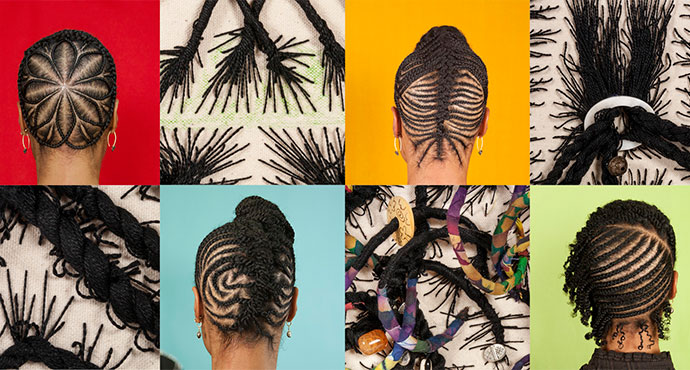A woman after my own heart, artist Sonya Clark is preoccupied with the texture, styling and politics of black hair. Her exploration of the theme through various works has captivated visitors to more than 250 museums and galleries in Europe, Africa, Asia, South America, Australia, and the U.S.
Currently, Richmond is lucky to have concurrent exhibitions of her work on display: “Same Difference” at Reynolds Gallery and The Hair Craft Project at 1708 Gallery. “Same Difference” features signature works Clark made of thread, her own hair and combs, which conjure a charged history of hair culture, race politics and contested notions of beauty. “The Hair Craft Project” features the creations of a dozen hair stylists working alternately on two backdrops—Sonya’s head and stitched canvases—to dramatic effect.
Both shows are must-sees for anyone interested in viewing hair in new and significant ways. Clark is a master of weaving story through art, and tangling our perceptions of function and aesthetics along the way. Here she answers some questions about “The Hair Craft Project.”
What was the origin of The Hair Craft Project?
Almost 20 years ago, photographer and art critic Bill Gaskins did a review of my work and said, “Hairdressing was the primordial fiber art form.” I have been quoting him, misquoting him and using that phase since then. I thought, Great, I’m trained as a textile artist and I’m obsessed with hair. He just put it in a nice little phrase.
With this project, I just decided that it was time to go to the source of it all, which was the hairdressers themselves. I thought, Why not engage them completely and fully into the dialogue about hairdressing being the first textile art form? By giving them my hair as the textile or the fiber that I grow and then giving them these manipulated canvases that are like flattened wigs with thread, that sort of cements the premise.
The work they’ve done is outstanding. I can’t get over how they’ve proved that phrase that Bill Gaskins said so many years ago.
As an artist, do you have goals for your work? If so, what’s the goal of this project?
It aspired to put this premise that hairdressing is the first textile art form, or the first fiber art, into action. If that’s true, hairdressers should be really good textile artists. That aspiration is absolutely true in the hands of these women.
They hit the ball out of the park in terms of what they were able to do with these canvases, which were really new to them. None of them had done anything like that, except hairdressing.
Another one of the goals is to bring together two worlds that I belong to. One is the black community. No one looks at me funny when I walk into a hair salon, especially a natural hair salon. That world is filled with its own sense of aesthetics, craftsmanship, entrepreneurial spirit, tradition, improvisation and all of the things I think are important to the art world.
It’s not this way everywhere in the art world, but Richmond’s art scene can be somewhat racially stratified. This is one way of bringing one art community, the hairdressing art community, together with another community, a gallery art community. I belong to both of them. I feel like it’s natural for me to make the introduction.
That’s one of the goals, too, to look at the parallel practices and think about hairdressing as a craft form and art form. It’s not only to think about it, but to demonstrate that and break down some barriers.
As an artist, any time I’m doing a collaborative project, I’m always hoping to learn something I wouldn’t learn if I was sitting in my studio working with my assistant. This project has certainly been that. There were things I learned sitting in the women’s salons in their chairs as they were talking. I learned about how people run their businesses, about their skill sets as artists, about their skill sets as businesswomen, and about natural hair care.
I could read 100 books and not have learned the same amount that I learned from those ladies. They reminded me of a lot of artists I know in terms of why they do what they do or why they came to it. For many, art gives strength, purpose and a sense of fortitude. There are a lot of parallel stories that way.
The Hair Craft Project
1708 Gallery in Richmond, Virginia, is hosting The Hair Craft Project, an exhibition led by artist Sonya Clark, which explores hairdressing as the primordial textile art form—the earliest manipulation of fiber toward an aesthetic and functional purpose. Artists from VCU’s Craft and Material Studies program prepared canvases hand-stitched with threads to simulate hair growth. Local hairstylists will each be given a stitched canvas and the opportunity to braid it as skillfully as possible. Photographs of stylists’ creations on Clark’s head will be shown in conjunction with the canvases. The project aims to break down barriers by crossing boundaries between hair salons and art galleries as sites of aesthetics, craft, skill, improvisation, and commerce. Click here for more details.
FEBRUARY 14- MARCH 8, 2014
People’s Choice Award: Vote for your favorite artworks and hairstyles
THURSDAY, FEBRUARY 27, 5:30 PM
Gallery talk with Bill Gaskins and juror A’Lelia Bundles
THURSDAY, MARCH 6, 5:30 PM
Gallery talk with Henry Drewel, Ruti Talmor, and juror Lowery Stokes Sims
The featured stylists include Kamala Bhagat, Dionne James Eggleston, Marsha Johnson, Chaunda King, Anita Hill Moses, Nasirah Muhammad, Jameika Pollard, Ingrid Riley, Ife Robinson, Natasha Superville, and Jamilah Williams.


